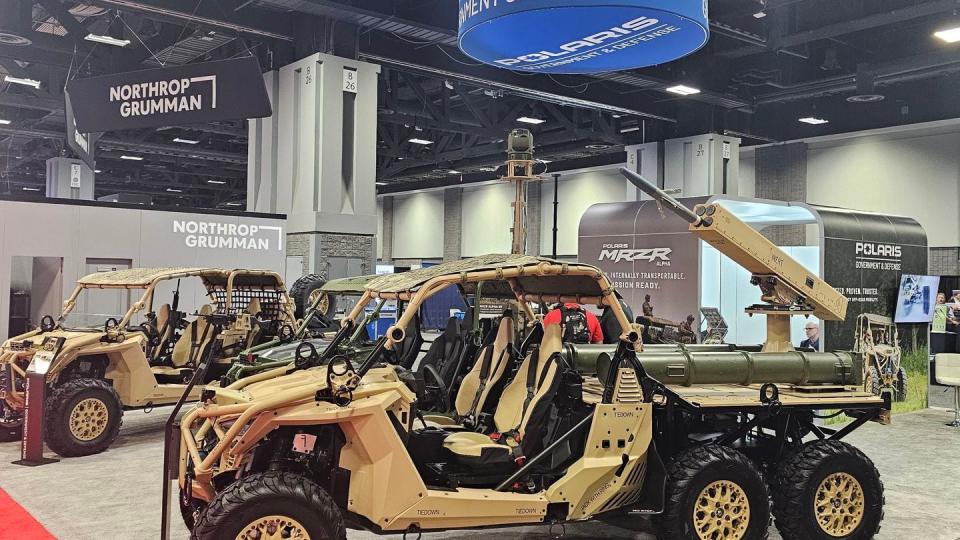Marines, special ops test MRZR vehicles that add power, payload capacity
Polaris has a version of its MRZR Alpha vehicle able to power offboard systems that’s nearing production, as well as a heavy-payload variant undergoing testing with the Marine Corps and U.S. Special Operations Command, the manufacturer told Defense News.
Program manager John LaFata said developing the ability for MRZR light vehicles to generate electricity to power radars, networks, weapons and the like “has been the Marine Corps’ No. 1 focus with us over the last year.”
To that end, Polaris created two products: a 1-kilowatt exportable power system that can be added onto existing vehicles by installing a kit, and a 5-kilowatt system that can be built into new vehicles on the production line.
Both use a DC-to-DC power converter that connects to the existing MRZR alternator to export 24-volt power. The system communicates with the engine on how much power is needed, and it only revs the engine to a higher speed if the plugged-in weapon or sensor demands more power, according to the company.
LaFata said the power export systems could allow Marines to use technology without having to haul around a separate generator to power them. For example, they could take advantage of the additional energy to power the Networking On-the-Move satellite communications system; the Common Aviation Command and Control System, which combines data from air- and ground-based radars and sensors; and the light version of the Marine Air Defense Integrated System.
He said one of the Marine Coprs’ requirements is for the power-export technology to not take up cargo space. As such, Polaris’ offering includes a DC-to-DC converter tucked between the two rear seats, a power distribution unit and fuse box in the pillar next to the rear passenger side seat, and a small switch installed on the dashboard.
LaFata, showing off the kit installed on a vehicle at the Modern Day Marine conference earlier this month, noting unit maintainers can install the 1-kilowatt version.
Polaris delivered several prototypes of the 5-kilowatt variant to the service this year, and those are now going through testing at the Nevada Automotive Test Center. LaFata said production is expected to begin on both variants in the third or fourth quarter of this year.
In parallel, Polaris is working with the Marine Corps and Special Operations Command to fund this effort as an engineering change proposal to their existing Ultra Light Tactical Vehicle and Lightweight Tactical All Terrain Vehicle contracts, respectively.
Separately, Polaris is working with both organizations to determine what need, if any, exists for an MRZR vehicle with six times the payload weight capacity.
The company took its two-seat MRZR Alpha, added a mid-drive axel and extended the deck to create a longer truck with greater payload space and weight capacity — 3,600 pounds, compared to the 600 pounds of cargo the traditional two- and four-seat Alphas can carry.
LaFata said a V-22 Osprey aircraft can still internally transport the vehicle, which he added has more than 90% parts commonality with the original Alphas.

A display vehicle at Modern Day Marine had an Advanced Precision Kill Weapon System rocket launcher installed on the bed of the truck. But LaFata said the importance is the space and weight capacity of the new Alpha variant.
“It just gives a number of capabilities. Again, sticking with the Alpha concept, which is modularity and the ability to be that Swiss Army knife of a vehicle, you can do a number of things back here: [casualty evacuation], logistics, lethality,” he said.
Polaris in January delivered several vehicles to the Corps and the command to experiment with. The Marine Corps Warfighting Laboratory, for example, has conducted logistics exercises and precision-fires tests with the prototype, LaFata said, as the service considers what it could put on the back of the truck and if it fills a need.
LaFata said Polaris saw a gap in the vehicle inventory between the MRZR and the Joint Light Tactical Vehicle, and thought the firm could fill the gap by creating this heavy payload version of the MRZR. Now, they’re putting the prototype into the hands of operators to determine it indeed fills a gap.

